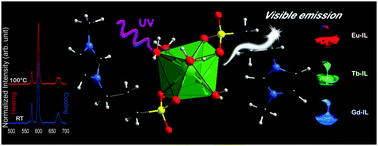Thermoreversible luminescent ionogels with white light emission: an experimental and theoretical approach†
Abstract
We report here the development of transparent and luminescent ionogels that consist of complexes formed by an ionic liquid and lanthanide salts (europium, terbium, or gadolinium). To obtain these soft materials, we use a methodology that involves a room temperature reaction lasting a few minutes and no use of solvent, stirring or heating. The ionogels exhibit intense emission lines upon UV light irradiation, and were characterized by luminescence spectroscopy performed at different temperatures, FTIR and NMR spectroscopy, and thermogravimetric analysis. We performed a theoretical study on the luminescence properties of ionogels comparing the experimental and theoretical results. The model Sparkle/RM1 was applied to forecast the system geometry and the INDO/S-CIS model was used to calculate the energies of excited states. The intensity parameters were predicted based on Judd–Ofelt theory and the theoretical model based on 4f–4f transitions was applied in the calculation of transfer and energy retrotransference, radioactive and nonradiative decay rates, and finally the quantum efficiency. The materials obtained have excellent photophysical properties (high lifetime, narrow line width and high degree of color purity) which make them extremely valuable for various optical applications.


 Please wait while we load your content...
Please wait while we load your content...